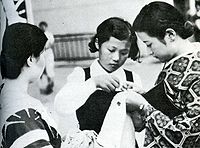
Senninbari
Encyclopedia

Amulet
An amulet, similar to a talisman , is any object intended to bring good luck or protection to its owner.Potential amulets include gems, especially engraved gems, statues, coins, drawings, pendants, rings, plants and animals; even words said in certain occasions—for example: vade retro satana—, to...
by women to soldiers on their way to war as a part of the Shinto
Shinto
or Shintoism, also kami-no-michi, is the indigenous spirituality of Japan and the Japanese people. It is a set of practices, to be carried out diligently, to establish a connection between present day Japan and its ancient past. Shinto practices were first recorded and codified in the written...
culture of Imperial Japan.
Construction, and types
Senninbari were most commonly made from white cloth, but yellow, red, green, and blue were also used. Stitches were usually red, but again a range of other colors were sometimes used. The stitches were usually arranged in multiple rows but might also be placed in patterns creating images of flags, patriotic slogans and tigerTiger
The tiger is the largest cat species, reaching a total body length of up to and weighing up to . Their most recognizable feature is a pattern of dark vertical stripes on reddish-orange fur with lighter underparts...
s. The most common slogan was bu-un cho-kyu for "eternal good luck in war". Tigers were popular as they were known to be able to roam far away from home and then return safely.
Senninbari took various forms including hachimaki
Hachimaki
A hachimaki is a stylized headband in Japanese culture, usually made of red or white cloth, worn as a symbol of perseverance or effort by the wearer. These are worn on many occasions, for example, by sports spectators, by women giving birth, students in cram school, office workers, expert...
(headbands), belts, vests, and caps. Rare forms of senninbari take the form of good luck
Luck
Luck or fortuity is good fortune which occurs beyond one's control, without regard to one's will, intention, or desired result. There are at least two senses people usually mean when they use the term, the prescriptive sense and the descriptive sense...
flags. Senninbari made to be worn around the waist, as the majority were, were called senninbari-haramaki (a haramaki
Haramaki
Haramaki is a type chest armour worn by the samurai class of feudal Japan and their retainers.-Description:Haramaki were originally constructed with the same materials as the o-yoroi but designed for foot soldiers to use as opposed to the o-yoroi which was for mounted warfare...
or abdomen belt is traditionally worn in Japan
Japan
Japan is an island nation in East Asia. Located in the Pacific Ocean, it lies to the east of the Sea of Japan, China, North Korea, South Korea and Russia, stretching from the Sea of Okhotsk in the north to the East China Sea and Taiwan in the south...
to help maintain good health). These belts generally measure about 6 inches high by 31-36 inches long+/-. Some of these belts were called "tiger belts", if embroidered in the image of a tiger.
History
The custom of producing senninbari originated during the First Sino-Japanese WarFirst Sino-Japanese War
The First Sino-Japanese War was fought between Qing Dynasty China and Meiji Japan, primarily over control of Korea...
of 1894-1895. As stated earlier, the red color of the stitches was considered a “lucky” color, and the belts were believed to confer courage, good luck and immunity from injury (especially bullets) upon their wearers. Some Japanese soldiers rejected the belief that the senninbari could protect them from harm. Instead, they felt that this good luck item would simply allow them to be in the position to inflict the greatest damage upon the enemy before offering their life up in battle. Others in the military wore the senninbari as a devotional to the women back home.
Makers
A senninbari could be made by a man's mother, sister, or wife if married, who would stand near their local temple, train station, or department store and ask any female passerby to sew in a French knot stitch. During the most hectic days of the War in order to meet demand, women's patriotic organizations would gather to make senninbari en masse. These were then placed in imonbukuro or comfort bags and sent overseas to the soldiers. According to the custom, any woman born in the "year of the tiger" could sew either 12 stitches or a number of stitches that added up to her age. Some belts were lined with the woman/women's hair as an added form of protection. The custom of placing hair in bags or pouches as a good luck charm, dates to early folk belief found on the island of Okinawa. Additionally, coins could be sewn into the belt as an amulet as well.In popular culture
Senninbari were featured in the 2006 movie Letters from Iwo JimaLetters from Iwo Jima
is a 2006 war film directed and co-produced by Clint Eastwood, and starring Ken Watanabe and Kazunari Ninomiya. The film portrays the Battle of Iwo Jima from the perspective of the Japanese soldiers and is a companion piece to Eastwood's Flags of Our Fathers, which depicts the same battle from the...
.

